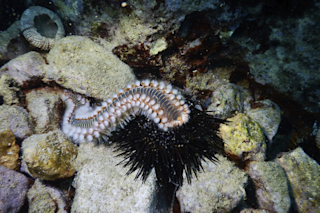Sea urchins living in the Mediterranean have a new enemy: the bearded fireworm. This toothless but determined predator has found a way to devour sea urchins, despite their spines and stony shells. And the worms’ appetite for urchins might remake entire ocean ecosystems.
The bearded fireworm, Hermodice carunculata, grows up to a foot long and is fuzzy, not in the cute way but in the “DO NOT TOUCH” way. The white tufts that run along the worm’s body are clusters of stinging bristles. The species lives in tropical coastal waters along both sides of the Atlantic Ocean. In recent years it’s also become more common in the Mediterranean, and in the past decade its population has surged along the coast of Italy. The reason for this surge is “still unclear,” says Roberto Simonini of Università degli Studi di Modena e Reggio Emilia in Modena, Italy.
When Simonini and other researchers ...














